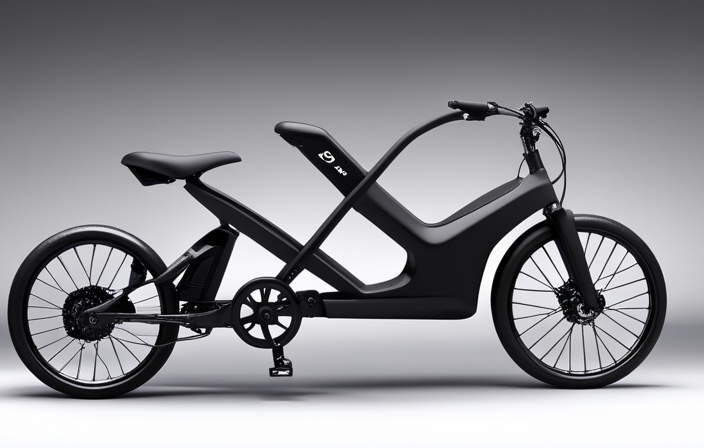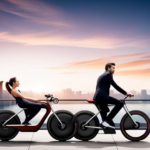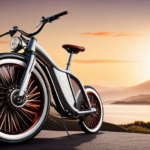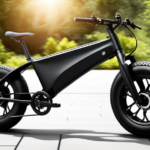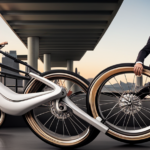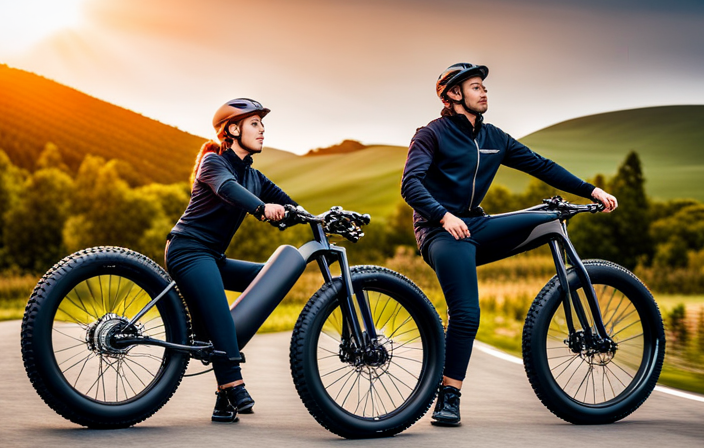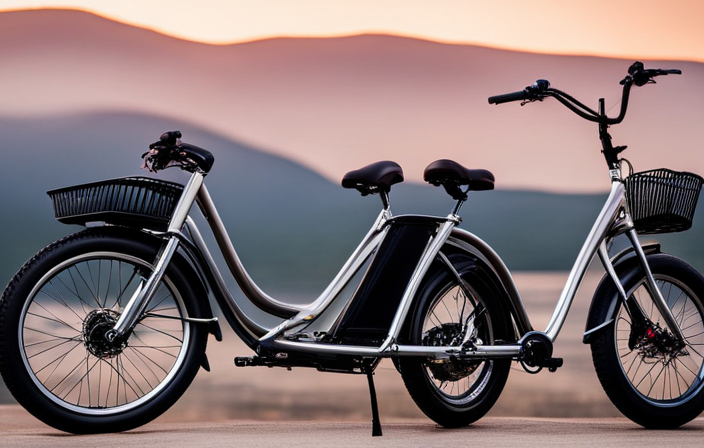Have you ever wondered how electric assist bikes work? Well, get ready to be amazed as I take you on a journey into the fascinating world of these innovative vehicles.
From the powerful motor to the advanced battery technology and intelligent sensors, every component of an electric assist bike plays a crucial role in enhancing your riding experience.
In this article, we will delve into the intricate workings of these bikes, unraveling the mysteries behind their pedal assist system and exploring the future developments in this exciting technology.
So, let’s dive in and uncover the secrets of electric assist bikes!
Key Takeaways
- Electric assist bikes provide a clean and efficient alternative to traditional vehicles, reducing reliance on fossil fuels.
- Electric assist bikes are suitable for densely populated areas with traffic congestion and pollution concerns, offering a greener option for commuting and running errands.
- Regular maintenance and care, such as cleaning the bike, checking tire pressure, keeping the battery charged, and inspecting brakes, are essential for the proper functioning of electric assist bikes.
- When choosing an electric assist bike, it is important to consider factors such as preferred riding style and terrain, motor power and location, battery capacity and range, as well as frame, weight, brakes, and suspension.
The Basics of Electric Assist Bikes
Electric assist bikes, also known as e-bikes, work by providing an additional electric motor that assists the rider’s pedaling. These bikes have gained popularity due to their pedal assist benefits, which allow riders to go faster and farther with less effort.
The electric motor is typically located in the hub of the front or rear wheel, or integrated into the bike frame. It is powered by a rechargeable battery, which can be easily removed for charging. The rider can control the level of assistance provided by the motor through a handlebar-mounted controller.
As the rider pedals, the motor kicks in and provides additional power, making it easier to climb hills or ride against strong headwinds. Understanding the motor is crucial in maximizing the benefits of an electric assist bike and keeping up with the latest electric assist bike market trends.
Understanding the Motor
The motor in an electric assist bike is responsible for providing additional power. It is made up of various components, including the rotor, stator, and magnets. When the rider pedals, the motor senses the force and activates, providing assistance to the rider.
The motor works by converting electrical energy from the battery into mechanical energy, which then helps propel the bike forward. The efficiency of the motor is an important factor to consider, as it determines how much power is effectively transferred to the wheels. Higher motor efficiency means that less energy is wasted, resulting in a longer battery life and a more effective electric assist.
Exploring the battery technology is the next step in understanding how electric assist bikes work, as it plays a crucial role in powering the motor and providing the necessary energy for the bike to function.
Exploring the Battery Technology
To understand how the battery technology in an electric assist bike functions, you should explore its components and capabilities. The battery charging process is crucial for the bike’s performance. Most electric bikes use lithium-ion batteries, which can be charged using a standard electrical outlet. These batteries have a limited lifespan, typically lasting around 2-3 years or 500-1,000 charge cycles. It’s important to note that the battery’s lifespan can be affected by various factors such as temperature, usage, and maintenance.
To maximize the battery’s lifespan, it is recommended to charge it fully before each ride and avoid completely draining it. Regular maintenance, such as keeping the battery clean and storing it in a cool place, can also help prolong its lifespan. Understanding the battery technology is essential for optimizing the performance and longevity of your electric assist bike.
Moving on to the next topic, let’s explore the role of sensors in electric assist bikes.
The Role of Sensors in Electric Assist Bikes
Sensors in electric assist bikes play a crucial role in optimizing performance and improving the riding experience. Sensor technology is integrated into various components of the bike, such as the motor, battery, and display. These sensors provide real-time data on factors like speed, cadence, torque, and pedal force.
By constantly monitoring these variables, the bike’s computer system can adjust the level of assistance provided by the motor, ensuring a smooth and efficient ride. Additionally, sensors can also detect changes in terrain and adjust the assistance accordingly, making uphill climbs effortless and enhancing overall control.
Furthermore, some electric bikes have sensors that can connect with smart devices through Bluetooth or wireless technology. This integration allows riders to track their performance, customize settings, and even receive navigation prompts right on their smartphones or smartwatches.
With the crucial role of sensors in electric assist bikes, let’s now delve into how the pedal assist system works.
How the Pedal Assist System Works
Get ready to experience the magic of effortlessly gliding through various terrains with the pedal assist system.
This innovative technology combines the power of your legs with the assistance of an electric motor, making your rides more enjoyable and efficient.
The pedal assist system offers different modes that allow you to choose the level of assistance you desire. Whether you want a gentle boost or a more powerful push, these modes cater to your specific needs.
Additionally, the system provides different power output levels, allowing you to control the amount of force the motor contributes to your pedaling. This ensures a seamless riding experience, whether you’re tackling steep hills or cruising along flat roads.
As we delve into the different levels of assistance, you’ll discover the full potential of electric assist bikes.
The Different Levels of Assistance
Explore the variety of assistance levels available to you and discover how they enhance your riding experience.
When it comes to electric assist bikes, there are different types of motors that provide varying levels of assistance. The most common types are hub motors and mid-drive motors. Hub motors are located in the front or rear wheel and provide a smooth and quiet ride. On the other hand, mid-drive motors are positioned in the bike’s center and offer better weight distribution and a more natural feel.
Another factor to consider is the battery range and capacity. Higher capacity batteries allow for longer rides without needing a recharge.
Transitioning into the next section about regenerative braking and energy recapture, it’s important to understand how these different levels of assistance impact the overall efficiency and performance of the bike.
Regenerative Braking and Energy Recapture
Regenerative braking and energy recapture are two features that enhance the overall efficiency and performance of the e-bike.
Regenerative braking allows the electric motor to act as a generator when the rider applies the brakes. This converts the kinetic energy of the moving bike into electrical energy, which is then stored in the battery for later use. This process not only slows down the bike but also helps to recharge the battery, increasing its efficiency.
Energy recapture, on the other hand, involves capturing the energy that is typically lost during braking and deceleration. This energy is converted into electrical energy and stored in the battery. By recapturing this energy, the e-bike can extend its range and reduce the amount of power needed from the battery.
By implementing regenerative braking and energy recapture, e-bikes can maximize battery efficiency, allowing riders to travel longer distances on a single charge. This feature also helps to reduce the environmental impact of the bike by utilizing energy that would otherwise be wasted.
Moving on to the benefits of electric assist bikes, they offer a range of advantages for riders of all levels of fitness and experience.
The Benefits of Electric Assist Bikes
One of the advantages of e-bikes is that they can provide a boost to riders of all fitness levels. Whether you’re a seasoned cyclist or just starting out, an electric assist bike can make your ride easier and more enjoyable.
The electric motor provides assistance when you need it, whether you’re climbing a steep hill or simply trying to keep up with faster riders. This means that you can go farther and faster without feeling exhausted.
Additionally, e-bikes can be a great option for people with physical limitations or injuries, allowing them to still enjoy the benefits of cycling. The electric assist also makes commuting by bike more feasible, as it reduces the effort required and allows for a quicker and less sweaty arrival.
In the next section, we will explore how electric assist bikes improve commuting.
How Electric Assist Bikes Improve Commuting
Improve your daily commute by effortlessly reaching your destination with the help of an electric assist bike. Electric assist bikes, also known as e-bikes, are designed to improve efficiency and reduce the carbon footprint of commuting.
These bikes are equipped with an electric motor that provides assistance when pedaling, making it easier to tackle hills and longer distances. The motor is powered by a rechargeable battery, which can be easily charged at home or at work.
By using an electric assist bike, you can save time and energy on your daily commute while also reducing your reliance on fossil fuels. Additionally, e-bikes allow you to stay active and enjoy the health benefits of cycling, without exerting as much effort.
Transitioning into the subsequent section, the impact on physical fitness is another important aspect to consider.
The Impact on Physical Fitness
Using an e-bike can still provide health benefits, as it allows individuals to stay active with less effort. While electric assist bikes may require less physical exertion compared to traditional bicycles, they still offer numerous physical benefits.
Regular cycling, even with the assistance of an electric motor, can improve cardiovascular fitness, increase muscle strength, and enhance overall endurance. The low impact nature of cycling also reduces the risk of joint and muscle injuries, making it a suitable exercise option for individuals of all fitness levels. Additionally, the ability to adjust the level of assistance on an e-bike allows riders to gradually increase their fitness levels over time.
Overall, the health impact of electric assist bikes is significant, offering a convenient and accessible way to improve physical fitness.
Transitioning into the subsequent section about electric assist bikes and environmental sustainability, it is important to consider the positive impact these bikes have on both personal health and the environment.
Electric Assist Bikes and Environmental Sustainability
To enhance your understanding of electric assist bikes and their impact on the environment, it’s important to consider their contribution to sustainable transportation.
Electric assist bikes play a crucial role in urban transportation by providing a clean and efficient alternative to traditional vehicles. By utilizing an electric motor to assist the rider’s pedaling, these bikes reduce the reliance on fossil fuels and help to decrease carbon emissions. This is particularly significant in densely populated areas where traffic congestion and pollution are major concerns.
Electric assist bikes offer a greener option for commuting, running errands, and navigating the city streets. Their ability to seamlessly integrate with existing transportation infrastructure makes them an attractive choice for environmentally-conscious individuals.
By incorporating electric assist bikes into our daily lives, we can make a positive impact on reducing carbon emissions and creating a more sustainable future.
Moving forward, let’s delve into the maintenance and care for these eco-friendly bicycles.
Maintenance and Care for Electric Assist Bikes
Maintaining and caring for electric assist bikes is essential to ensure their longevity and performance. To keep your electric bike in top shape, here are some key maintenance tips and a troubleshooting guide:
- Regularly clean the bike, especially the drivetrain, to prevent dirt and debris buildup.
- Check the tire pressure regularly and inflate them to the recommended level for a smooth and efficient ride.
- Keep the battery charged and avoid letting it fully discharge to prolong its lifespan.
- Inspect the brakes and adjust them if necessary to ensure optimal stopping power.
- Lubricate the chain and other moving parts to reduce friction and extend their lifespan.
If you encounter any issues with your electric assist bike, refer to the troubleshooting guide provided by the manufacturer. By following these maintenance tips and troubleshooting guide, you can maximize the performance and lifespan of your electric assist bike.
Now let’s move on to choosing the right electric assist bike for you.
Choosing the Right Electric Assist Bike for You
When considering which electric bike is right for you, it’s important to evaluate factors such as your preferred riding style and terrain. Electric assist bike features vary across different models, so it’s crucial to compare them to find the best fit.
One key feature to consider is the motor power and its location. Some models have a motor in the front wheel, while others have it in the rear or mid-drive. The battery capacity and range are also important factors, as they determine how far you can ride before needing to recharge. Additionally, consider the bike’s frame and weight, as well as the type of brakes and suspension it offers.
By comparing different electric assist bike models, you can find one that suits your needs and preferences. Transitioning into the next section about safety tips, it’s important to keep these features in mind for a safe and enjoyable ride.
Safety Tips for Riding an Electric Assist Bike
It’s crucial to prioritize safety while riding an electric assist bike. When riding in traffic, there are a few tips to keep in mind.
First, always be aware of your surroundings and anticipate the actions of other road users. Signal your intentions clearly and make eye contact with drivers when necessary.
Additionally, it’s important to wear the appropriate safety gear for electric bikes. A helmet is a must to protect your head in case of an accident. Reflective clothing and lights can also increase your visibility, especially when riding at night.
Remember to follow the rules of the road and be a defensive rider. By practicing these safety tips, you can enjoy a safe and enjoyable ride on your electric assist bike.
Looking ahead, future developments in electric assist bike technology will continue to enhance the safety and performance of these vehicles.
Future Developments in Electric Assist Bike Technology
Looking ahead, future developments in e-bike technology will continue to improve safety and performance.
With advancements in battery technology, e-bikes will have longer range and faster charging times. This will make them even more convenient and practical for daily commuting.
Additionally, improvements in motor technology will allow for more efficient power delivery, resulting in a smoother and more responsive riding experience.
Advanced sensors and algorithms will also enhance safety by providing real-time feedback and assistance to riders, helping to prevent accidents.
Furthermore, future e-bikes may incorporate features such as integrated GPS navigation, automatic collision detection, and even self-balancing capabilities.
These advancements in e-bike technology will have a significant impact on transportation, as more people will choose e-bikes as a sustainable and efficient mode of transportation, reducing traffic congestion and carbon emissions.
Frequently Asked Questions
Can electric assist bikes be ridden without using any pedal power?
Yes, electric assist bikes can be ridden without using any pedal power. The electric motor provides propulsion, allowing riders to rely solely on the motor for speed and efficiency. This makes it a great option for commuting and can contribute to weight loss.
Are electric assist bikes suitable for off-road terrain?
Electric assist bikes, or e-bikes, are not ideal for off-road terrain due to limited suspension and non-aggressive tires. However, advancements in electric assist bike features, such as improved suspension and rugged tires, are enhancing their suitability for off-road biking.
How long does the battery of an electric assist bike typically last before needing to be recharged?
The battery of an electric assist bike typically lasts for several hours of continuous use before needing to be recharged. Charging requirements vary, but most batteries can be fully charged within a few hours.
Can the level of assistance be adjusted on an electric assist bike?
Adjusting the assistance level on an electric assist bike is like adjusting the flow of a river. The higher the level, the more energy it requires from the battery, shortening its lifespan. Finding the right balance is key.
Are electric assist bikes legal on public roads and bike paths?
Yes, electric assist bikes are legal on public roads and bike paths, but there are regulations to be followed. They provide numerous benefits such as easier pedaling, extended range, and increased speed.
Conclusion
In conclusion, electric assist bikes are a remarkable fusion of technology and human power. As I glide through the streets, the smooth hum of the motor resonates with each pedal stroke, propelling me forward effortlessly.
The advanced sensors seamlessly detect my level of exertion, providing just the right amount of assistance. With cutting-edge battery technology, I can conquer long distances without worry.
It’s incredible to think about the future developments in this field, where electric assist bikes will undoubtedly become even more efficient and powerful. So hop on, embrace the future, and let these remarkable machines take you on an exhilarating journey.
